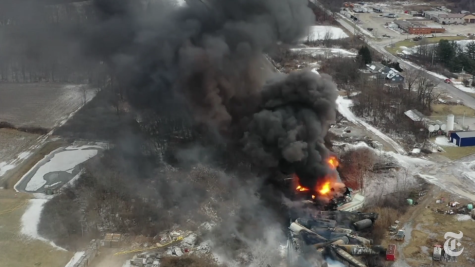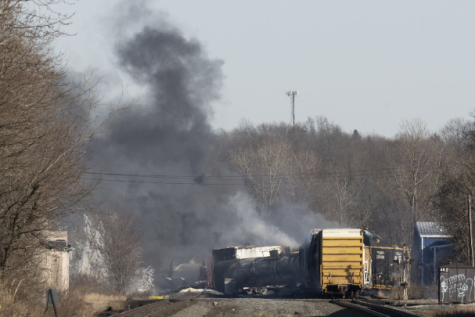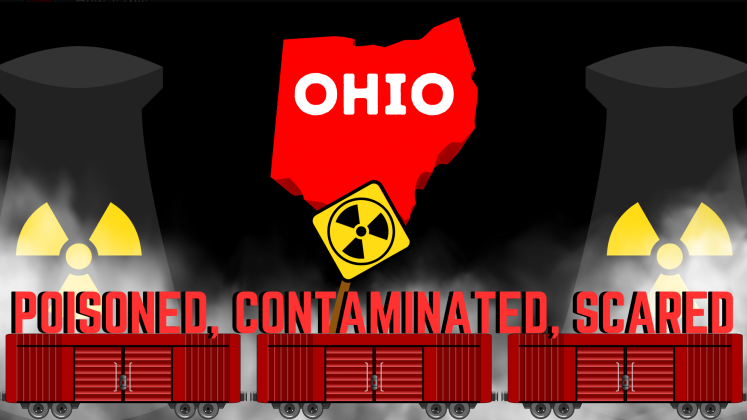Chernobyl 2.0: Ohio’s train crash leaves carcinogenic chemicals to kill, contaminate
On Feb. 3, a Norfolk Southern train of 50 cars, 20 of which contained hazardous materials, derailed in East Palestine, Ohio.
A controlled fire would be made in an attempt to prevent an explosion. According to STAT News, the hazardous materials being transported were “vinyl chloride, butyl acrylate, ethylene glycol, isobutylene, and ethylhexyl acrylate.” In simpler terms, the chemicals and compounds included are used to make PVC (pipes), acrylic materials, fuel, polyester, rubber, plastics, and adhesives. Two of the compounds have been classified as carcinogens, all are combustible, and some can even become immediately lethal upon ignition leaving some of Ohio contaminated with these carcinogenic compounds. With the initial accident and controlled burn now over three weeks old, things begin to turn for the worst for Ohio residents.

Many East Palestinian citizens and those in nearby communities (including some in neighboring Pennsylvania) evacuated the area in search of safer relocation. However, this hasn’t stopped the burning derailment from leaving its mark, sometimes rather ominously. According to Chemical & Engineering News, a Pennsylvanian citizen, Katlyn Schwarzwaelder, reported animals in her community, some young and healthy, dying unexpectedly since the accident, including a domesticated dog and fox. Several captive foxes at Parker Dairy also fell ill, with one dying, and the owner blamed the sudden illnesses and death on the derailment.
The chemicals have not only spread through the air but through waterways and streams as well, killing thousands of fish as a result. As of Feb. 23, the Ohio Department of Natural Resources (ODNR) reported the deaths of 3,500 aquatic creatures in Ohioan waterways, with a new calculation estimating the deaths of over 38,000 minnows. However, the ODNR is unsure if these deaths are due to the derailment.
“We do not believe any of these animals were made sick by the train derailment, but we have submitted those specimens to the Ohio Department of Agriculture and will wait for those test results before making that judgment,” ODNR Director Mary Mertz said. “We are continuing to monitor and assess the environmental impact during cleanup.” Though the ODNR has their doubts, without test results, it is still something to consider in the effects of this disaster.
People have unfortunately not been spared any sickness from the derailment’s effects. According to the BBC, some Ohio citizens have reported sudden side effects supposedly stemming from the accident, with officials even opening up a health clinic for affected and cautious individuals. “Since then, residents have reported headaches, nausea, burning eyes and sore throats,” the BBC said. “Officials in East Palestine, Ohio, are opening a health clinic for residents after a train accident sparked health fears.”

Some have speculated that Chicago could also fall victim to the chemicals. For Chicago, the only major effects that can stem from the accident will most likely be associated with railroad safety and management rather than chemicals poisoning Chicago water, air, and soil.
“By this derailment, [Chicago will] probably not directly [be affected], but the whole idea of rail safety comes into question,” Environmental Science teacher Michael Beeftink said. “When we look at environmental science, one of the things that are difficult…is direct causation. I would feel that there are direct causations here [concerning Pennsylvanian and Ohioan people and animals getting sick and/or dying]. You’d have to be able to prove that, and that becomes the difficult part. Because of the wind direction [Chicago will not be affected], not from Ohio. States to the east would be more likely affected or impacted.”
With the effects that the chemicals have had on both animals and people, it’s easy to say that this story deserves more attention than what it has been given. If the situation is poorly handled, millions of people could end up dying of cancer. Many on social media have begun calling this the largest environmental disaster in America, going so far as to nickname it “Chernobyl 2.0.” While Chicago may not be affected, it’s important to remember how serious the aftermath of the train crash and burn was, even if it may not affect some of the Midwest.

James "Jimmy" Ryan Prizant is a senior at Niles North and the first lead copy editor for North Star News. In his free time he enjoys bowling, listening...












